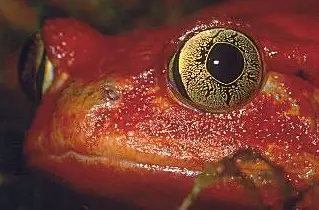American Green Tree Frog
The Tree Frog or the Peeper Frog is said to forecast rain, because he likes the humid weather, and after mating season he will sing on rainy nights, or very warm humid ones.
It is very seldom seen, but is always heard singing from trees or scrub, while feeding on insects. They winter in hollow trees or under stumps or any kind of hollow wooden cavity.
Like nearly every species of frog or toad, they must lay their eggs in water so in early summer they seek out a pool in the woodland, or a backwater, which will contain aquatic plants and is covered in higher vegetation around it.

American Green Tree Frog
The female will lay sometimes as many as 2000 eggs, which look like small globs of jam, and will stick tightly to stems or leaves that are submerged in the shallow water.
Within about 5 days the tadpoles will emerge, which are well equipped for life in the water by virtue of their gills.
They will remain in the water for about 2 months, during which a very gradual and very complex change takes place.
The rows of baby teeth are absorbed; the tiny mouth stretches and the gills are absorbed as is the tail.
Front legs emerge first, and then back ones, so strong that the little green frog can make jumps long enough that it seems to fly.
There are four toes on each foot, and all have small discs that are reminiscent of a suction cup, which help it to cling to smooth surfaces.

American Green Tree Frog
Metamorphosis completed they are able to emerge from the water and go immediately up a tree to live the remainder of their lives with the exception of mating season.
They are incredible in their method of changing color, however each change takes about an hour and are not made by choice, but instead by their surroundings.
Temperature and humidity seem to play a big part in the transformation that takes place, taking them from green to brown to yellow green and back again.
The diet of the green tree frog is crickets and other tree insects.
Find out more about the American Green Tree Frog over at Wikipedia »

